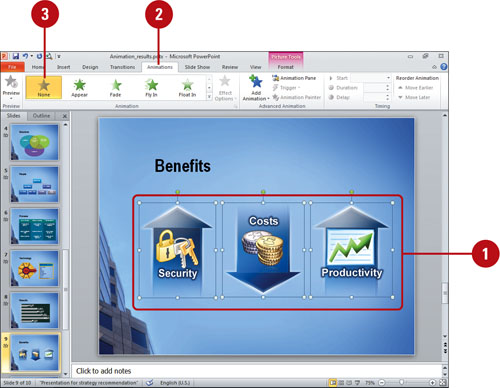You can use animation to introduce objects onto a
slide one at a time or with special animation effects. For example, a
bulleted list can appear one bulleted item at a time, or a picture or
chart can fade in gradually. There are four types of animations (New!):
Entrance, Exit, Emphasis and Motion Path (animations along a line). You
can apply one or more animations to the same object. To quickly see if
you like an animation, point to a name in the Animation list to display
a live preview of it. If you like it, you can apply it. You can also
design your own customized animations, including those with your own
effects and sound elements. If you no longer want to use an animation,
you can remove it.
Apply and Preview a Animation Effect to Text or an Object
- 1. Select the text or object you want to animate.
- 2. Click the Animations tab.
- 3. Click the Animation list arrow, and then point to an animation.
A live preview of the style appears in the current shape.
- 4. Click the animation you want.
- 5. To add multiple animations, click the Add Animation button, and then click the animation you want.
- 6. To preview an animation, click the Preview button.
- To stop an animation, click the Preview button again.
- To automatically preview an animation after adding or changing one, click the Preview button arrow, and then click AutoPreview to select it.

Remove an Animation
- 1. In Normal view, select the object you want to animate.
- 2. Click the Animations tab.
- 3. Click the Animations list arrow, and then click None.

Did You Know?
You can view a slide’s animation quickly in Slide Sorter view. In Slide Sorter view, click a slide’s animation icon to view the animation.
Add Sound to an Animation
- 1. In Normal view, select the object you want to animate.
- 2. Click the Animations tab.
- 3. Click the Animations Pane button.
- 4. In the Animation Order list, click the list arrow of the animation to which you want to add a sound, and then click Effect Options.
- 5. Click the Sound list arrow, and then click the sound effect you want.
- To add your own sound, click Other Sound from the list, select the sound you want, and then click OK.
- 6. Click OK.
- 7. Click the Play button to hear the animation effect.

|